-
Car Reviews
- Car News
-
Car Comparisons
Latest comparisons
- Chasing Deals
A base model Lexus RX costs about the same as a top-shelf Toyota Kluger. Both large SUVs have much to offer, but only one feels like a luxury car.
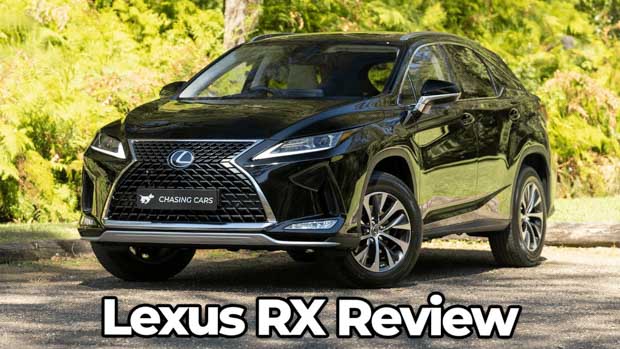
Unlike so many of its German luxury SUV competition, the 2022 Lexus RX actually rides comfortably.
This might sound absurd, but it isn’t. An emerging trend of the luxury SUV market is that optional adaptive or air suspensions are usually required to make a vehicle ride acceptably.
With the Japanese-built Lexus RX, that’s not the case. Choose the most affordable specification – the RX 300 Luxury tested here ($73,013 plus on-road costs) – and the ride is sublime right out of the box.
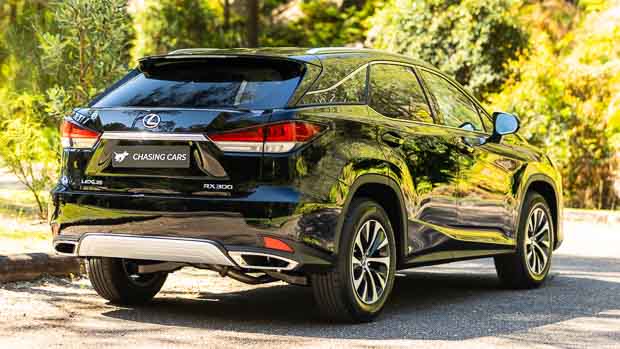
A swathe of recent suspension modifications prepared for the RX’s subtle mid-life facelift have also made this large SUV handle better, but this luxo-barge is mainly about cossetting its occupants.
Nothing wrong with that: not every SUV on the road has to be tuned to feel like a sports car. A good chunk of buyers in this aspirational segment are looking more closely at for soft, supportive seats, superb interior quality and a great ride than Nurburgring-tuned body control.
If you count yourself among that set – read on, as the Lexus RX 300 Luxury is designed for you.
The RX 300 engine is the most modest of three powertrains available with the Lexus RX.
This two-litre turbocharged petrol is the sole four-cylinder and sole front-driver of the lineup. While it’s outranked by the 221kW/370Nm 3.5-litre RX 350 V6 (from $83,013) and 230kW RX 450h V6 hybrid (from $91,760) engines higher in the range, the RX 300 will be enough for most.
Unlike the lusty V6 that likes a rev – or the electrified but heavier RX 450h – the RX 300 produces its 175kW of power and 350Nm of torque at lower engine speeds, allowing it to get by on low-end torque nearly all of the time.
There is a graininess to the turbo four-pot that you don’t find in the silkier RX 350 … but with the remarkably crisp standard 12-speaker stereo turned to moderate volume you simply don’t hear the engine at all.
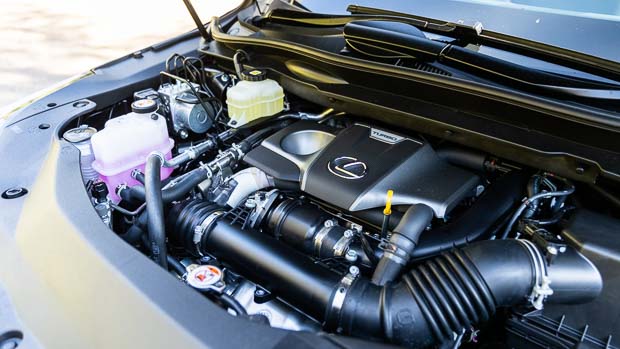
Sure, it’s a little workmanlike in application but it gets the job done without much by way of complaint or remark at all. And it’s a great match for the six-speed torque converter automatic, which slurs away efficiently in the background, ensuring you’re never far from peak torque.
About the only weak spot of the RX 300 powertrain is its front-wheel drive nature. 350Nm off the line is enough to chirp the front tyres, but little about this car encourages full-throttle starts. It prefers being driven gracefully – but if you have a leadfoot, go one of the V6 options.
Like many Lexus vehicles, the RX is available in base Luxury, athletic mid-tier F Sport and lush top-spec Sports Luxury grades.
The RX 300 Luxury tested here combines the most affordable engine with the entry-level trim. The $73K price means it crosses over with the seven-seat Toyota Kluger Grande – the mainstream alternative to the RX that uses a newer TNGA platform beneath.
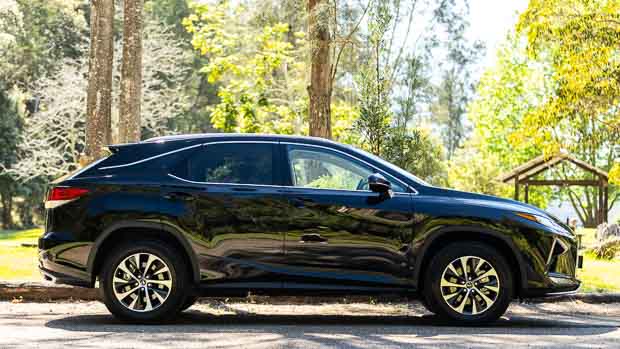
While that stiffer platform gives the Kluger a bit more prowess in fast cornering, the RX does not feel dated by comparison – far from it. The 4.9m Lexus is significantly quieter inside with fewer vibrations picked up from the road.
A $73K Kluger may give you blinged-out chrome 20-inch wheels – something similar costs $6000 more in RX-land – but the RX 300’s standard 18-inch alloys and chunky tyres deliver a superb ride.
The even, well-damped, supremely compliant ride is the defining characteristic of the RX 300 Luxury’s dynamics – endowing it with a truly relaxing demeanour.
Sydney traffic is enough to get anybody’s hackles up but in the RX 300 on 18s… you just don’t care! You sit high above it in a leather-lined sanctuary feeling little other than the slight vibration of the four-pot engine and the bass line from your music.
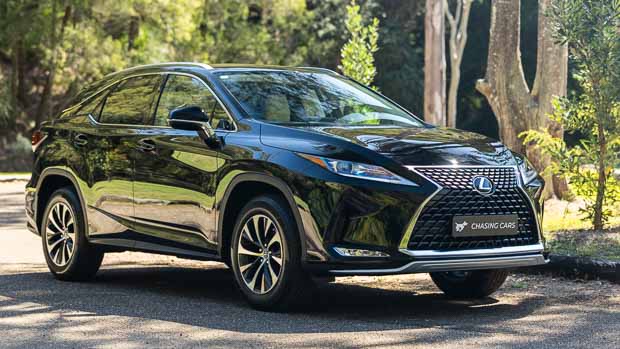
The subtle mid-life upgrade to the RX brought with it a number of refinements under the skin to the suspension, notably including extra spot welds and greater quantities of adhesive.
A slight stiffening of the suspension has not impacted ride quality at all – instead, the changes successfully reined in the pre-facelift RX’s nautical body control.
No longer feeling boat-like, the RX manages to soak up bumps while preventing the body from lolling about in the corners or, more noticeably for most drivers, when coming to a complete stop at traffic lights.
This still isn’t a sporty SUV – it can certainly handle a winding country road at speeds faster than most would attempt, demonstrating surprising flair and deftness, but the RX still feels a bit out of its comfort-zone driven this way.
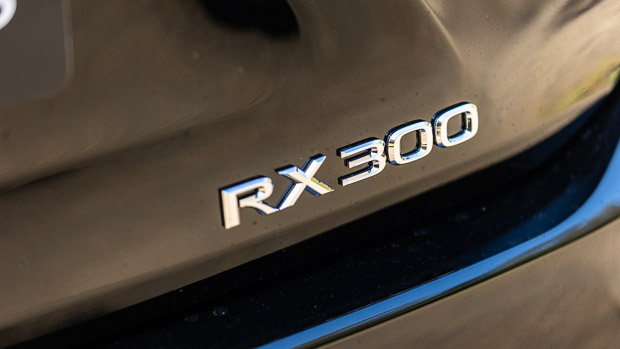
Those looking for an overtly athletic experience will still get more out of a lower-tier BMW X5, but you’ll also pay more – $104,400 for an entry-level four-cylinder turbo diesel version.
On the safety front, the RX gained a number of features at facelift time. In addition to pre-existing forwards AEB, junction-turning AEB and reversing AEB were fitted and became standard equipment.
Blind spot monitoring, rear cross-traffic alert and lane keeping assist are also standard, though the lane-hold tech is really quite subtle. The Genesis GV70 and GV80 have better-tuned and more sensitive lane keeping systems.
At this level of the RX range, you only get a reversing camera, rather than a 360-degree camera of that sort that has become fairly common on high-tier mainstream SUVs – including the Kluger.
The fourth-generation RX launched in 2015 but a range of small changes have kept the interior feeling reasonably up to date.
Most significant was last year’s decision to equip the RX with a new 12.3-inch touchscreen, with the display unit moved forward to be more accessible to the front seat occupants. At the same time, wired Apple CarPlay and Android Auto capabilities were added.
Those changes were most welcome, as the Lexus infotainment system is fairly clunky and dated. Time breeds familiarity, but plugging in and using your smartphone’s OS feels much more natural in this vehicle.
The polarising Lexus Remote Touch trackpad persists between the seats as a secondary control mechanism, though it is worth noting that the smaller Lexus NX, which launches in new second-gen form in early 2022, has ditched the touchpad in favour of a huge new 14-inch touchscreen.
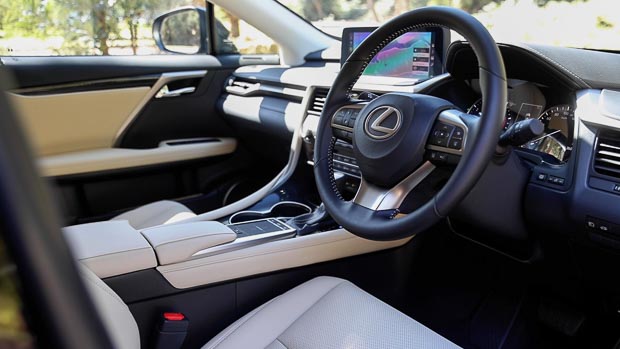
We imagine that the next iteration of the RX will also adopt this new Lexus infotainment system – also found on the next American-market Toyota Tundra ute – but for now, the current setup does the job.
Ahead of the driver sit a set of elegant analogue dials. The needle and typeface are large enough to identify your speed at a glance, which is helpful … as the RX 300 Luxury lacks a digital speedometer. Higher-grade variants equipped with a heads-up display have the function.
A Bluetooth connection is established very quickly and was rock-solid in our testing – plus, our own music sounded pretty decent through the base RX’s 12-speaker system. The premium 15-speaker Mark Levinson stereo in higher RX grades is truly excellent, however.
Leather seating is standard-fit and available in a choice of black or ivory. Our test car sported a classic onyx black-over-ivory specification. “3D Film” trim is standard, though higher grades nab real wood.
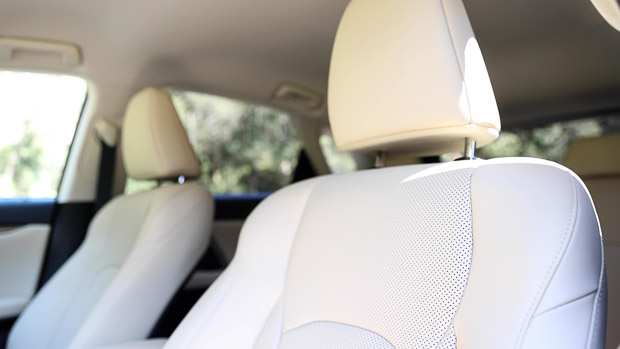
The seating position is best described as high and commanding, though the shapely seat ensures you don’t feel like you ride the RX. Drivers enjoy a good view over traffic but you are ensconced within the RX even if the base car does not score the stronger lateral bolstering of F Sport grades.
Electric seat adjustment is standard, but despite this car’s premium positioning, seat memory, heating and cooling are optional. Sadly, these comfort options are bundled with 20-inch wheels, preventing buyers from retaining the base grade’s unique level of refinement if they want their posterior warmed or ventilated.
Secondary material quality is superb throughout the cabin, with soft touch surfaces found virtually everywhere – including the tops of the rear doors and across the plushly-padded door and central armrests. Road trips in this car come easily.
Item storage is above-average, with a smart rubberised vertical phone holder hiding screens from view, while there is a standard Qi wireless charging pad ahead of the shifter. Decent-sized cup holders and clever extendable door bins mean you’ll find a slot for your bottle.
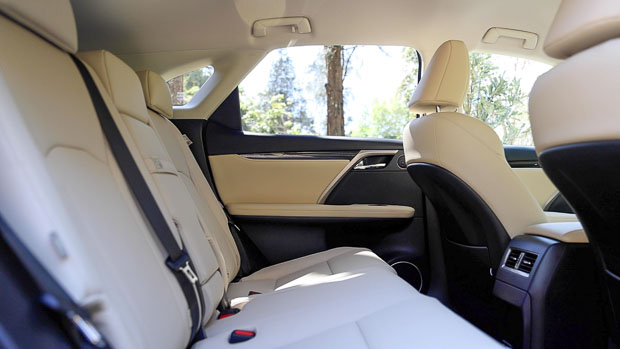
Space in the rear is excellent, mainly because the RX is pretty big – 4.9m long in short-wheelbase, five-seat form, 5m in longer-wheelbase seven-seat L spec.
That means plenty of legroom, headroom and toe room for adult passengers, while the completely flat floor means you can seat an adult in the middle seat for shorter trips with few complaints.
The RX misses rear climate zone adjustment from the second row, though, but you will find air vents. A deeply-upholstered flip-down armrest is appreciated but the RX would further benefit from sun blinds located in the rear doors.
Behind a power tailgate (with an obnoxiously large BEEP as it opens and closes) is a 453-litre boot – not massive for the segment, though our suitcase set fit without issue, and there is a space-saver spare located beneath the carpeted boot floor.
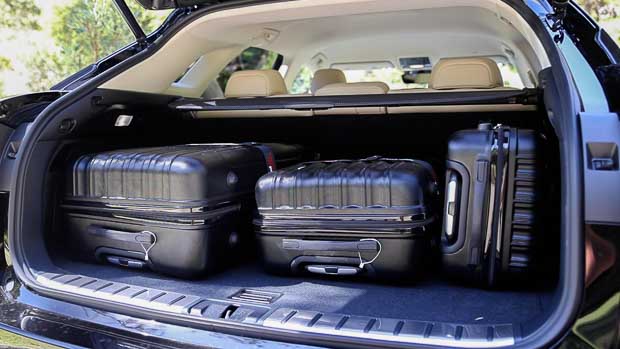
There’s no doubt that the hybrid V6 RX 450h offers the lowest running costs of any Lexus RX, but it costs much more than the base RX 300 turbo petrol. $18K more, in fact – buying you a fair amount of fuel if you’re fine with the performance of the two-litre.
Across our week of combined driving we managed to score 11L/100km, which for a relatively powerful, torquey, heavy (1995kg) large SUV, is acceptable if not great.
For reference, our testing of the hybrid has yielded 8L/100km in the past – meaning it’d take you well over a decade to break even on purchasing the hybrid instead.
Still, if cost isn’t the most pressing factor, you may like the opportunity to reduce your vehicular carbon footprint, not to mention the additional refinement of the electrified six-cylinder.
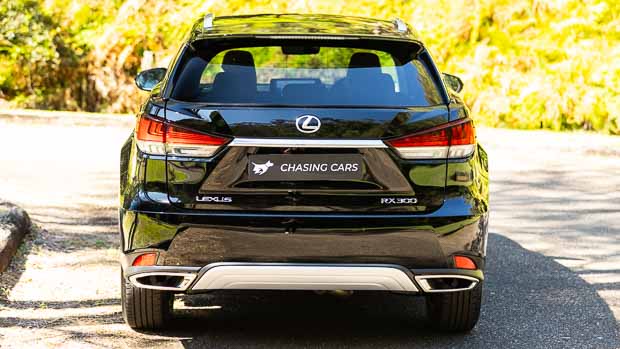
Like all Lexus cars sold in Australia, the RX 300 is covered by a four-year/100,000km warranty that is merely average for the luxury car space. Mercedes-Benz offers five-year/unlimited km coverage, as do Volvo, Jaguar and Land Rover. Audi and BMW’s three year warranties are rated as poor by Chasing Cars.
That being said, the Lexus-Toyota reputation for quality precedes the vehicles they make and often for good reason.
Capped price servicing is published for the Lexus RX across a three-year/45,000km period. Each annual/15,000km service is priced at $595, giving a three year cost of $1785, which is slightly better than average for the large luxury SUV space.
The Lexus RX 300 Luxury is an underrated player in the luxury SUV space.
Truly comfortable – from the compliant suspension, sensible wheels, deeply-upholstered seats and whisper-quiet cabin noise levels – the RX soothes you as you drive.
That might sound pinched from a brochure. It isn’t – it’s simply that those attributes have become rare as luxury manufacturers increasingly orient their entire Australian line-ups towards sporty trims.
Traditionally luxurious barges absolutely continue to have a role to play. If the goal is plush, controlled family transport, the Lexus RX 300 Luxury fulfils the brief.
Variant tested LUXURY
Key specs (as tested)
About Chasing cars
Chasing Cars reviews are 100% independent.
Because we are powered by Budget Direct Insurance, we don’t receive advertising or sales revenue from car manufacturers.
We’re truly independent – giving you Australia’s best car reviews.
The estimate provided does not take into account your personal circumstances but is intended to give a general indication of the cost of insurance, in order to obtain a complete quote, please visit www.budgetdirect.com.au. Estimate includes 15%^ online discount.
^Conditions Apply
Budget Direct Insurance arranged by Auto & General Services Pty Ltd ACN 003 617 909(AGS) AFSL 241 411, for and on behalf of the insurer, Auto & General Insurance Company Limited(ABN 42 111 586 353, AFSL 285 571).Because we don’t know your financial needs, we can’t advise you if this insurance will suit you. You should consider your needs and the Product Disclosure Statement before making a decision to buy insurance. Terms and conditions apply.
Indicative quote based on assumptions including postcode , 40 year old male with no offences, licence suspensions or claims in the last 5 years, a NCD Rating 1 and no younger drivers listed. White car, driven up to 10,000kms a year, unfinanced, with no modifications, factory options and/or non-standard accessories, private use only and garaged at night.
^Online Discounts Terms & Conditions
1. Discounts apply to the premium paid for a new Budget Direct Gold Comprehensive Car Insurance, Third Party Property Only or Third Party Property, Fire & Theft Insurance policy initiated online on or after 29 March 2017. Discounts do not apply to optional Roadside Assistance.
2. Discounts do not apply to any renewal offer of insurance.
3. Discounts only apply to the insurance portion of the premium. Discounts are applied before government charges, taxes, levies and fees, including instalment processing fees (as applicable). The full extent of discounts may therefore be impacted.
4. We reserve the right to change the offer without notice.